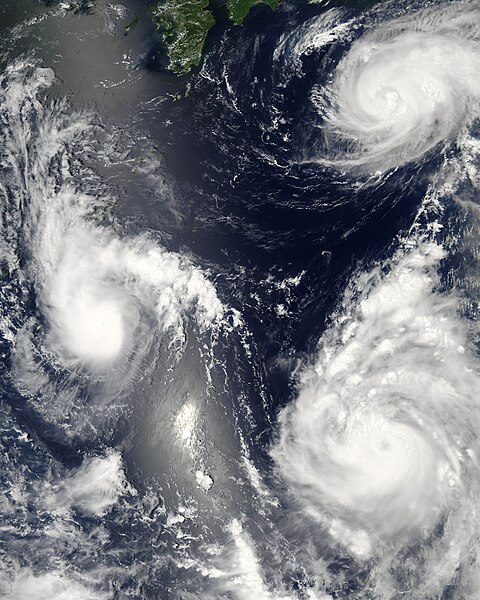Ficheiro:Maria, Bopha and Saomai 2006-08-07 0435Z.jpg

Dimensões desta antevisão: 480 × 600 píxeis. Outras resoluções: 192 × 240 píxeis | 384 × 480 píxeis | 614 × 768 píxeis | 819 × 1 024 píxeis | 1 638 × 2 048 píxeis | 7 200 × 9 000 píxeis.
Imagem numa resolução maior (7 200 × 9 000 píxeis, tamanho: 7,6 MB, tipo MIME: image/jpeg)
Histórico do ficheiro
Clique uma data e hora para ver o ficheiro tal como ele se encontrava nessa altura.
| Data e hora | Miniatura | Dimensões | Utilizador | Comentário | |
|---|---|---|---|---|---|
| atual | 03h06min de 8 de agosto de 2006 |  | 7 200 × 9 000 (7,6 MB) | Good kitty | == Summary == {{Information |Description=Three different typhoons were spinning over the western Pacific Ocean on August 7, 2006, when the Moderate Resolution Imaging Spectroradiometer (MODIS) on NASA’s Aqua satellite acquired this image. The strongest |
Utilização local do ficheiro
As seguintes 2 páginas usam este ficheiro:
Utilização global do ficheiro
As seguintes wikis usam este ficheiro:
- ar.wikipedia.org
- az.wikipedia.org
- bg.wikipedia.org
- bh.wikipedia.org
- crh.wikipedia.org
- cs.wikipedia.org
- de.wikipedia.org
- en.wikipedia.org
- Typhoon
- Typhoon Saomai
- Tropical cyclone
- Wikipedia:Picture peer review/Archives/Archive2006
- User:Plasticup/MyFavorites
- Typhoon Maria (2006)
- User talk:Hurricanehink/Archive 23
- User talk:Thegreatdr/2012archive
- Wikipedia:Wikipedia Signpost/2013-11-20/Traffic report
- Wikipedia:Wikipedia Signpost/Single/2013-11-20
- Wikipedia:Top 25 Report/November 10 to 16, 2013
- User:Tfmbty/2006 Pacific typhoon season
- User:SongdaTalas/Archives of Former Articles
- en.wiktionary.org
- es.wikipedia.org
- fi.wikipedia.org
- hi.wikipedia.org
- id.wiktionary.org
- incubator.wikimedia.org
- ja.wikipedia.org
- ja.wikibooks.org
- ko.wikipedia.org
- lo.wikipedia.org
- ms.wikipedia.org
- my.wikipedia.org
- nn.wikipedia.org
- no.wikipedia.org
- ro.wikipedia.org
- ru.wikipedia.org
- szy.wikipedia.org
- th.wikipedia.org
- tk.wikipedia.org
- tr.wikipedia.org
- tt.wikipedia.org
Ver mais utilizações globais deste ficheiro.





